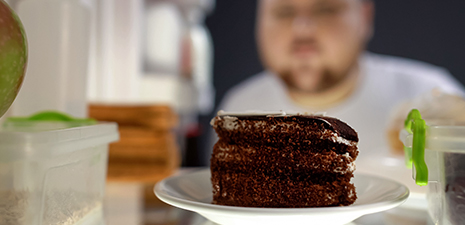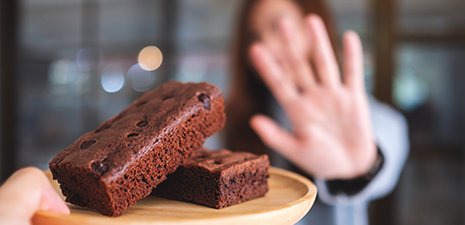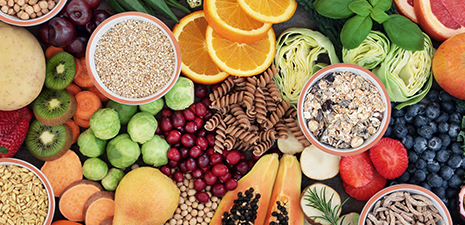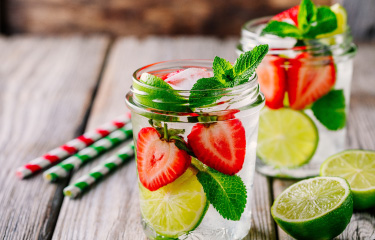We all need a little something sweet once in a while, and there’s nothing wrong with treating yourself to dessert now and then. But is something triggering your sugar cravings? Find out how to manage your sweet tooth with dietitian Melissa Nieves.

What Your Food Cravings Really Mean
Do cravings mean you’re actually hungry? Often, the answer to that question is “no.”
Cravings only last a short time, while real hunger doesn’t go away. Real hunger pangs are different from a sudden craving usually cued by seeing, smelling, or hearing about the desired food. There is the biological side of hunger and eating, and then there is the psychological, emotional part of the equation.
I come from an Italian background where food and drink are used to celebrate, well, practically everything. Many of us use food to comfort ourselves, soothe hurt feelings and unhappiness, or to numb ourselves against feeling much at all. And, in a crisis situation, what does my family do? Well, we cook, of course!
For all of us, certain foods have a powerful history and can return us to warm, nurturing feelings from our childhood when we were rewarded or treated with a special food. Just think about how most of us associate cupcakes with fun.
Emotional and Stress Eating
We all fall into patterns of unconscious snacking while watching television or movies, on long car rides, or even when cooking dinner—but sometimes our treats are planned. Many of my women patients, for example, find that after a long day of taking care of everyone else’s needs, their only self-nurturing “me” time is when they have a favorite food after dinner, by themselves, while watching a show.
According to a Harris Poll, nearly eight out of 10 women and seven out of 10 men in the United States feel guilty about the food they eat.1 Half of women surveyed reported food guilt when eating with friends, and 12 out of 20 also said they feel guilty about what they eat when alone. And, it’s not just women; half of men also feel the same way.
We are hard on ourselves when we eat in unhealthy ways, whether it’s binging, snacking all day on empty-calorie foods, going back for seconds, or just having that big piece of cake.
Of course, we know in our brains what we should and should not be eating, but often we eat with our emotions. But this needn’t be framed as a constant struggle between our emotions and our thinking brain—it’s about self-awareness and changing our behavior. Let me assure you, we can change our ways of thinking and our habits around food.
What it takes is developing some awareness of what’s driving our behaviors. Let’s start with a little biology.
The Hunger Hormones
We have two hormones that influence whether we feel hunger and when we feel full: ghrelin and leptin. Ghrelin is secreted primarily in the stomach and sends signals to the brain that increase hunger when nutrients are needed. The problem is when you cut calories or eat less, ghrelin spikes and makes you feel hungry. This is why it is hard to stay on a diet. Our brains are wired to see food and eat it. We haven’t yet evolved past our hunter-gatherer ancestors who never knew when the next meal would be, or the next famine. Our modern brains know that the delicious bread served before dinner will be available tomorrow and the next day, and the next, but the more primitive brain is yelling, “There’s food right there in front of you. You may not see this for months. Hurry up and eat it!”
Leptin is secreted mainly in fat cells and works to decrease hunger. So, you might assume that more fat cells creating more leptin would eventually send a signal to the brain that would control hunger and encourage weight loss. This is what happens for some people on a low-carb, keto-inspired diet. But for many people, this isn’t the case, because of something known as “leptin resistance.”2 Having a long history of eating too much high-fat food scrambles the signals for hunger, which leads to our brains not receiving the “I’m full” message.
Here are some ways to keep ghrelin levels down and decrease your hunger:
- Avoid extreme diets: The yo-yo effect confuses the ghrelin and leptin signaling.
- Catch more zzzs: Lack of sleep is seen as a cause in weight gain and can increase ghrelin levels.3
- Increase strength training: Increased muscle mass is linked to lower levels of ghrelin.
- Eat plenty of lean protein: This can lower ghrelin and reduce hunger.
Who Wants the Fries: Your Body or Your Brain?
Unfortunately, when we crave a certain food, kale is usually not what leaps to mind first. We most often crave high-fat foods, salty snacks, chocolate, or other sweets. Pickles and ice cream are the classic stereotypical cravings of pregnant women, and it’s true: hormonal changes can affect the sense of smell and taste, causing unusual cravings and aversions.
Hunger and cravings operate a bit differently. The hunger signaling is centered in the hypothalamus region and is part of the primitive limbic system that also controls thirst and body temperature. Cravings—and the satisfying of them—is all about the reward centers such as the ventral tegmental area, the nucleus accumbens, and the prefrontal cortex. This is where reward and motivation happen. When you bite into a warm, melty slice of pizza, you receive a nice blast of dopamine, a neurotransmitter that delivers a feeling of pleasure, and sometimes even euphoria. This is a brain reward, which it will remember and want to repeat.
A University of Exeter study used brain MRIs to show that the brain regions involved in learning, memory and reward are all activated by drugs, alcohol, and high-fat, high-sugar foods.4 A high reward center response corresponded with more potato chips eaten. And it didn’t matter how hungry the subjects felt. Clearly, our brains are wired to eat more and it takes some effort to change our routines, our brain’s responses, and ultimately our choices and behaviors around eating.
When to Give In to Cravings
Completely eliminating favorite foods or even severely restricting certain foods or food groups often backfires. It leads to thinking more about that particular food, feeling deprived, and then thoughts about how to obtain that food and eat it can consume you, and maybe even lead to a guilty binge. Moving foods out of the everyday category and into the “once a month” or “only at a restaurant” lane is a good way to cut back on them, enjoy them, and savor their taste without completely eliminating them.
If you can’t shake a craving, eat the food, but stick to a standard serving size. Labeling foods as “bad” or “good” gives them too much power. A healthy, balanced diet includes the foods you love, in moderation. It’s important to remember that, and to not feel guilty when we satisfy a craving.
A healthful diet does not include trying to ignore frequent hunger pangs and deprivation. Undereating can make food cravings much worse, especially for calorie-dense foods including fried and processed foods, chocolate, and ice-cream. Instead of waiting for intense feelings of hunger, it is better to have a regular pattern of healthy, well-balanced meals and healthful snacks planned throughout the day to avoid potential cravings before they even start.
Rx Only. For the safe and proper use of Plenity or more information, talk to a healthcare professional, read the Patient Instructions for Use.
- http://www.prweb.com/releases/2015/05/prweb12739141.htm
- Gruzdeva O, Borodkina D, Uchasova E, Dyleva Y, Barbarash O. Leptin resistance: underlying mechanisms and diagnosis. Diabetes Metab Syndr Obes. 2019;12:191–198. Published 2019 Jan 25. doi:10.2147/DMSO.S182406
- Schmid SM, Hallschmid M, Jauch-Chara K, Born J, Schultes B. A single night of sleep deprivation increases ghrelin levels and feelings of hunger in normal-weight healthy men. J Sleep Res. 2008;17(3):331–334. doi:10.1111/j.1365- 2869.2008.00662.x
- University of Exeter. “Snacking and BMI linked to double effect of brain activity and self-control.” ScienceDaily. ScienceDaily, 23 July 2012. www.sciencedaily.com/releases/2012/07/120723105424.htm





